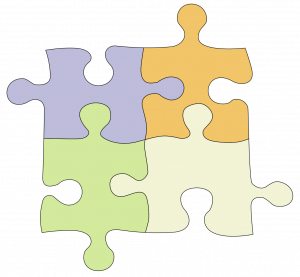Chapter 07: SIMPLE SOAP – NOTE EXAMPLES

Simple Soap – Note Examples
So far we have taken a look at the various pieces of a SOAP-note. Before we discuss how to construct them individually, let’s look at how they fit into the big picture of a completed SOAP note. The following are simple SOAP notes to give us a frame to view the SOAP note through.
There are 4 Examples to review (click the example to navigate to it quickly):
Example 1
Let’s look at the following simple SOAP note example.
S: Patient states that he did not sleep well last night due to phantom limb pain, RLE; he hopes to take his prosthesis home with him soon so he can use it to walk around the house “like a normal person”.
O: Gait training: With AK prosthesis in parallel bars, 30′ x 2, with mod A. Transfers: Sit to / from stand from w/c: min assist with verbal cues for hand placement. Patient flexes trunk forward and laterally to R during R LE weight bearing on the prosthesis. Therapeutic Exercise: Mat exercise program: glut sets, SLR, side-lying hip adduction and abduction; 3 sets of 12 reps each bilaterally. Manual stretching of R hip flexor with patient in L side-lying, 3 x 30 second hold. Right hip flexion contracture of 20 degrees (measured in supine).
A: Right gluteus medius weakness and hip flexion contracture causing patient to lateral trunk flex to R. Patient not ready to take prosthesis home until he can ambulate with walker with only supervision assistance. Presently he is a fall risk if he were to ambulate at home with prosthesis.
P: Continue gait training activities; concentrate therapeutic exercises on gluteus medius strengthening and hip extension ROM as per PT POC.
Your Name along with SPTA / Your CI’s name. (Or whatever signature format your clinic uses).
Doc Ex 24: A Summary and an Activity…
Can you see how this particular note ties together:
- A key point from the Subjective to
- A treatment element in the Objective to
- An analysis point (and safety recommendation) in the Assessment to
- What will be included in subsequent treatments (per the Plan)
Questions:
If I wanted to have the note reflect the statement about phantom limb pain, what additional information / type of information would you want to see in the:
- Subjective section?
- Objective section?
- Assessment section?
- Plan
Example 2
S: Patient notes decreased cervical pain after last treatment; now able to rotate her neck to the left to look for traffic while driving. No pain medications required today.
O: US: 100% 1.2w/cm2, 1Mhz x 5′ to R UT, rhomboids, LS mm in sitting. STM, TPR to R UT, rhomboids, LS mm in sitting. Therapeutic exercise per flowsheet.
A: Patient with improving c-spine ROM and decreased pain. Compliance with HEP is excellent is allowing her to recover without use of pain medications.
P: Continue 2x/weekly per PT POC.
Doc Ex 25: Refinement Activity
The note above is a bit like one you might see in an outpatient clinic. It does lack for details though.
- What additional information would you need for a more thorough pain entry?
- The Objective section tells us to refer to the flow sheet for information about ther ex. What type of exercises might we find there — what would be the goal of the exercises given the limited information you have on the patient?
- The Assessment section offers that the patient has excellent compliance with the HEP. That is great news. However, if the patient is still coming to PT (as per the Plan), what might you, as the clinician, included in today’s treatment session with respect to the HEP?
- The Assessment also notes increasing C-spine ROM. How does the therapist know? What is missing from the Objective section?
- Any other thoughts to improve this note?
Example 3
S: Patient reports 0 – 3/10 right knee pain; increasing up to a 5/10 only when he twists the knee during ambulation.
O: Therapeutic exercise per flowsheet. Modalities: NMES right quads, 50pps, 10 sec on/off x 10 mins w/ QS with patient in long sitting. Cold pack to right knee post NMES. Education: HEP Instruction: Reviewed present activities, as per flow sheet, with patient completing all activities without pain: 2 sets of 8 reps. Verbal cues needed for SLR technique only. Upgrades these activities to 3 sets of 10 – 12. After training, added standing lunges and wall slides (2 sets of 8) to HEP. Strength: MMT knee extension: Left: 5/5; Right 4/5. Gait training on level surfaces (with SPC) to reduce effects of circumduction on right. Integrated use of mirror for visual feedback as well as the use of a foot ladder (20′). Patient requires 25% verbal cues to make corrections during these activities.
A: Patient’s pain is steadily reducing despite intermittent exacerbations during twisting movements. Gains noted in strength and tolerance for exercise. Patient’s circumducting gait does cause a twisting moment at the knee which increases his discomfort. As noted, this deviation is improving through various PT interventions. It is reasonable to expect that a continued improvement with this deviation, through gait training and strengthening activities, should allow the patient to return to his premorbid pain free state of ambulation without AD.
P: Continue 3x/weekly progressing therapeutic exercise and gait activities per POC.
Doc Ex 26: You make the call…
This note offers a bit more detail in both the Objective and Assessment sections. Can you appreciate how the added detail explains ‘why’ the patient is experiencing pain and ‘why’ the PT interventions noted are being used.
- If you were the individual paying for the PT treatment, is there anything else you would want to know? Please describe or list and then explain why.
- If reviewing PT notes to determine if the treatment should be paid for was your job, what advice would you give to clinicians who are hoping to get paid for their services based on the content of their documentation?
Example 4: What’s missing?
So now you have seen a few examples of SOAP notes. All very generic and primarily focused for an outpatient clinic. Let’s look over this example to see what is missing.
S: Patient reports they had some pain last night, but not much pain now.
O: Transfers: W/C to mat. Patient loses balance to left sometimes.
Therapeutic exercise: Seated balance activities. Knee extension and hip flexion.
Gait Training: RW length of PT gym twice.
A: Patient progressing with exercises.
P: Continue BID per POC plan.
Doc Ex 27: Something(s) is missing…
For each entry (S, O, A, P) in the example above:
- Please list what information is missing — in other words, if you were with the clinician who wrote this note, what would you ask them? What do you need to know? What is missing?
 YOUR TURN ACTIVITY
YOUR TURN ACTIVITY
Let’s see if you can identify the section of the note for each entry: S, O, A or P.

